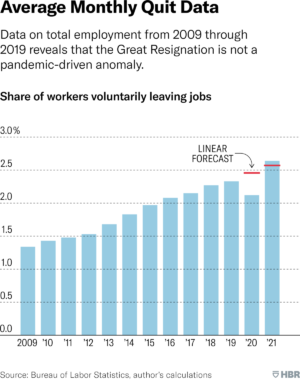Despite Winds of Recession, Unemployment Remains Low and Employee Expectations are Strong
While we may not technically be in a recession, many economists say we are approaching one. Terms such as “bear market” and “lowercase or uppercase” recession are commonplace. A trip to the gas station is both eye-catching and painful. Buying a house is becoming a luxury for only the wealthiest of Americans. And inflation is at its highest level in 40 years.
Typically, during recession unemployment rates increase. In this recession or looming recession, however, employment rates remain strong, and power is still tipping towards employees. In past recessions, management did not have to worry about employee engagement and satisfaction which makes this recession very different. A wave of changes to increase employee wages and working conditions has taken hold. This raises the question as to how strategic leaders should respond to the current economic environment.
Since its founding eight years ago, Summit Leadership Partners has worked with companies looking to scale their business. These companies understand the importance of keeping their employees engaged and aligning the employees’ interests with the goals of the companies. Without strong employee engagement and alignment, companies struggle to achieve their goals.
Strategic leaders in today’s economic environment should not be rolling back the measures initially taken to support their employees during the pandemic, such as higher wages, hybrid and flexible work options, and improved leave policies. Instead leaders should be, to the extent practicable, incorporating these measures as the new normal into their business strategy to be successful in the long run.
There are several reasons for this:
- hiring rates have outpaced quit rates since 2020;
- this trend began long before the pandemic (beginning in 2009) and,
- significant economic events have historically led to lasting impacts on the labor market.
The U.S. chamber of commerce has presented data indicating that people have been quitting their jobs in search of better opportunities at historically high rates. Despite this, hiring rates have outpaced quit rates since November of 2020. The phenomenon often described as the “great resignation” may more appropriately be named the “great reshuffle”. The industries with the most job openings are transportation, healthcare, education, retail, hospitality, and food. Companies are quickly learning that the benefits provided prior to 2020 are no longer competitive and that to retain workers their approach to people management must change.
Business, professional services, and other “white collar” industries have been less impacted. One reason is the nature of the work in these industries is much more conducive to remote and hybrid work, which helps lower attrition. These white-collar professionals have now proven themselves to be successful while operating outside the confines of the traditional “in-office” work environment.
Many companies, including Google, Apple, Citibank, and American Express, are trying to force employees to return to the office and are getting backlash from those employees who now prefer more flexibility. A Gallup study found that 91% of U.S. workers hoped that they could continue working some of their hours from home and 30% of workers suggested they would seek new employment if they were called back into the office.
While the pandemic accelerated the rising rate of U.S. workers choosing to leave their employers, it is important to note that quit rates have steadily risen as early as 2009, further suggesting this may be a secular, not cyclical trend. See the average monthly quit data from 2009-2019 in the chart below (HBR), which shows quit rates increasing up until the pandemic hit at which point there was a brief reverse and then a dramatic swing upwards.

While society has made dramatic strides in automation and technology to increase efficiency and productivity over the last several decades, it has not crossed over and impacted the treatment of employees or respect of their time. People are burnt out and tired and it’s showing. Employees are making it clear that the traditional 9 to 5 workday in the office no longer is consistent with their preferred lifestyle and employees are increasingly gravitating toward companies that allow for more flexibility.
Whenever there is a significant economic event there tends to be lasting impacts, often in ways that are unpredictable or unintuitive at the time. For example, the great depression led to the federal minimum wage, child labor laws, and laws protecting unionization.
The silver lining to this pandemic is the new and more accommodating outlook/treatment companies are having towards their employees. Companies who are not changing their policies in many cases are feeling the impact of this trend the hardest and struggling to find and retain their talent.
Summit uses specific tools, such as Entromy’s Organization Health Index, to help organizations measure internal employee engagement, which is key to understanding and retaining employees. Studies have shown high employee engagement leads to superior outcomes, including improved team performance, service quality, customer satisfaction, loyalty, business growth, market share, profit, and total shareholder return.
Employee engagement increases when employees feel satisfied, when they voluntarily advocate for their employer, have pride, and are committed to the organization. These are unprecedented times that require unprecedented solutions. Now more than ever it is critical that leaders evaluate the needs of their organization to ensure there is alignment for success.